KR1 (Kent Ridge 1)
EO
Ocean
Multi-purpose imagery (ocean)
Land
Quick facts
Overview
| Mission type | EO |
| Agency | NUS |
| Mission status | Operational (nominal) |
| Launch date | 16 Dec 2015 |
| Measurement domain | Ocean, Land |
| Measurement category | Multi-purpose imagery (ocean), Multi-purpose imagery (land) |
| CEOS EO Handbook | See KR1 (Kent Ridge 1) summary |
KR1 (Kent Ridge 1)
Overview Spacecraft Launch Mission Status Sensor Complement References
Overview
In 2013, NUS (National University of Singapore) embarked on a microsatellite program, called Kent Ridge 1 (the university's main campus is located in southwest Singapore at Kent Ridge), in collaboration with BST (Berlin Space Technology) for hyperspectral imaging applications. The overall objective is to integrate a VNIR/SWIR FTR (Fourier Transform Recovery) instrument into a microsatellite in support of disaster monitoring in Asia. Such instruments will provide many new applications in the monitoring of land, water & vegetation and thus will be useful to contribute towards the effort to prevent and manage such disasters in this region. 1)
Kent Ridge 1 was built alongside a comprehensive training program that will enable NUS to build small satellites on a system level, based on the LEOS (Low Earth Orbit Satellite) platform after the completion of the program. Seven Trainees from NUS currently undergo training both by BST and its educational partner TU (Technical University) Berlin. In a first step basic space training is given by online lectures of TU Berlin. Afterwards, starting in October 2014 the trainees will join the BST team for integration of the KR1 satellite. In parallel satellite design courses and hands on training will be given. In parallel to the delivery of KR1 a second satellite in parts and pieces will be delivered to NUS. These satellite components have FM level and can be used to build the second satellite based on KR1 in Singapore.
In May 2013, a contract was signed between NUS, BST and TU Berlin for the design and development of the Kent Ridge 1 microsatellite and its payload, involving also a training program for NUS students. The TU Berlin training focused on basic space training. The TU Berlin educational training was conducted between January to August 2014 via telepresence learning.
The BST training will focus on system design, AIT (Assembly, Integration and Test) and operational aspects. The BST training is scheduled from October 2014 to satellite delivery in the spring of 2015. The BST team will guide the NUS engineers through the design of the KR1 microsatellite and its payload, providing also on-the-job training experience.
Project milestones:
• The Kent Ridge 1 program of NUS was started in June 2013 with the kick-off meeting in July 2013.
• In February 2014, the project passed the CDR (Critical Design Review)
• The start of systems integration and test is scheduled for October 2014
• The FRR (Flight Readiness Review) is scheduled for October 2015
• The launch window will open in Q4 2015.
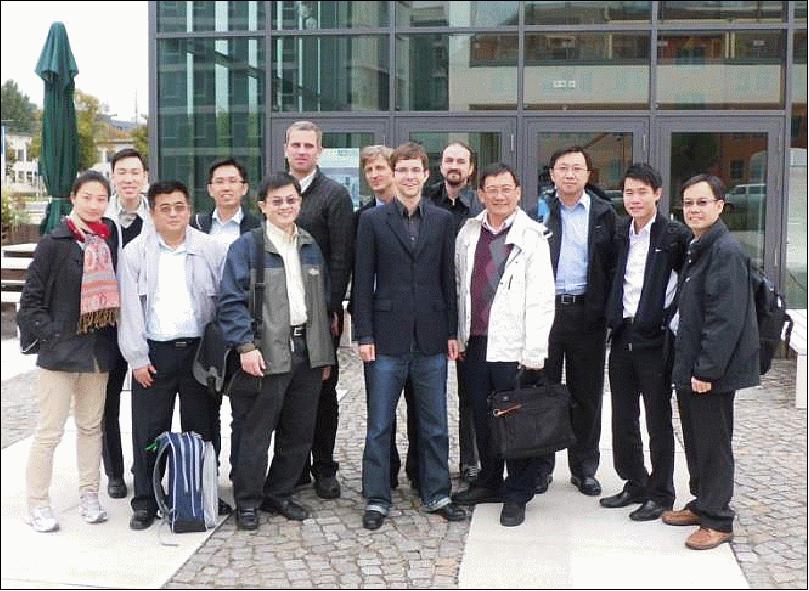
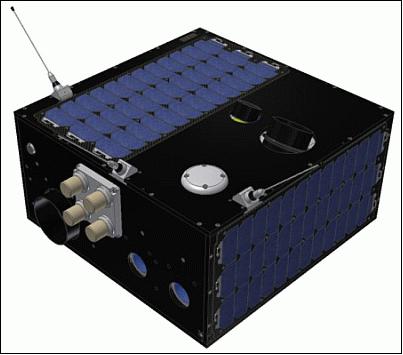
Spacecraft
Kent Ridge 1 is a microsatellite, based on the LEOS-50 (Low Earth Orbit Satellite-50) platform of BST, with a mass of 78 kg and a size of 575 mm x 572 mm x 384 mm that is jointly build by NUS and BST as part of a training program. It carries three payloads including two hyperspectral cameras, based on the FTR (Fourier Transform Recovery) method, developed by DSO (Defence Science Organization) National Laboratories, Singapore. The goal of KR1 is to test the FTR filters in space in a hyper spectral satellite mission. 3)
The LEOS-50 platform features a box design that has been enlarged to suit all components. The solid aluminum structure simplified the mechanical design, integration and testing. Furthermore,the platform supports a passive thermal control regime and provides good radiation protection.
The bus of KR1 has the following key specifications:
• 3-axis stabilized ADCS (Attitude Determination and Control Subsystem) based on reaction wheels and star trackers
• The EPS (Electrical Power Subsystem) is based on body mounted GaAs panels and LiFePO4 (Lithium Iron Phosphate) battery
• RF communications: UHF TM/TC system for telemetry and command, 100 Mbit/s X-band for data download.
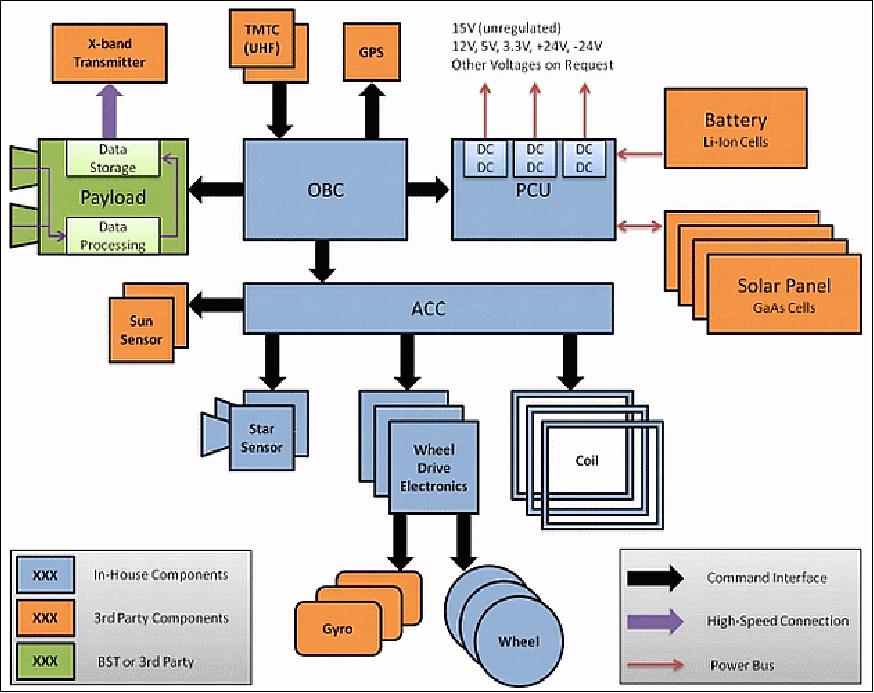
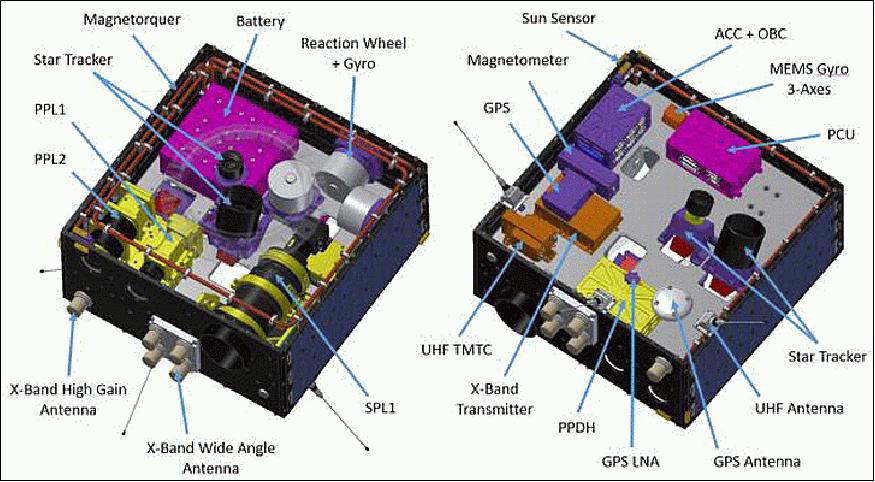
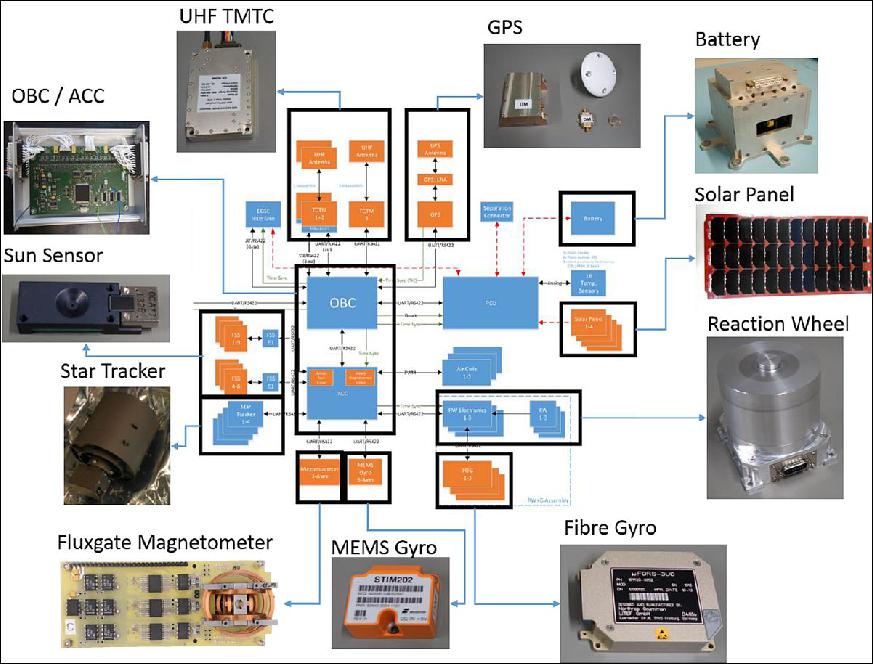
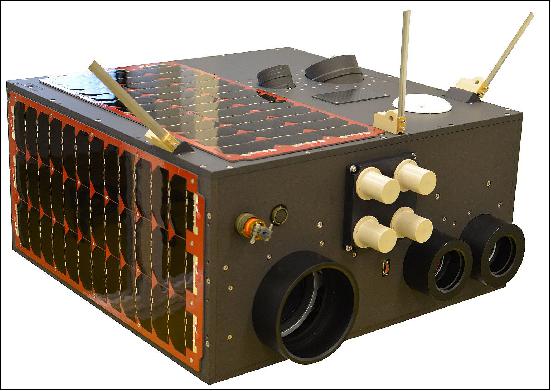
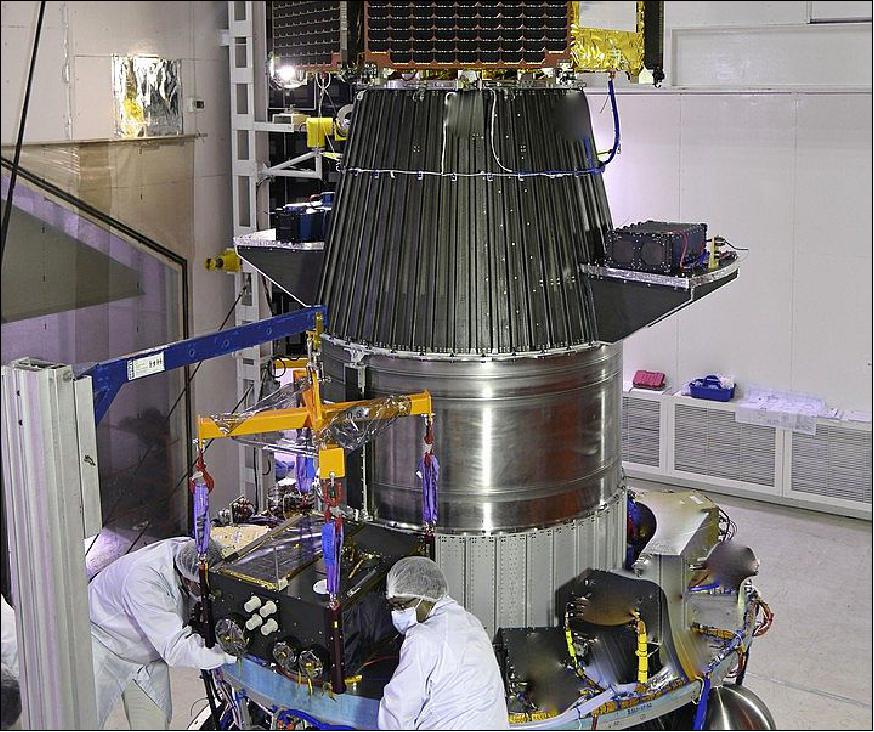
Launch
The Kent Ridge 1 microsatellite was launched as a secondary payload on December 16, 2015 (12:30:00 UTC) on a PSLV-C29 launcher of ISRO from SDSC (Satish Dhawan Space Center) at Sriharikota on the east coast of India. 4) 5) 6) 7)
The primary payload on this flight was TeLEOS-1, a commercial imaging minisatellite (400 kg) of AgilSpace, Singapore. A contract between ST Electronics AgilSpace of Singapore and Antrix Corporation was signed in Feb. 2014. 8)
The secondary payloads on this flight were:
• VELOX-C1, a minisatellite (123 kg) of NTU (Nanyang Technological University), Singapore.
• VELOX-2, a 13 kg 6U CubeSat of NTU, Singapore. A technology demonstration mission for intersatellite communication.
• Kent Ridge 1, a microsatellite (78 kg) of NUS (National University of Singapore) for Earth observation.
• Galassia, a nanosatellite (2U CubeSat, 2 kg) of NUS, Singapore with the objective to acquire TEC (Total Electron Count) data in the ionosphere.
• Athenoxat-1, a 3U CubeSat (technology demonstration) of NTU, Singapore.
Orbit: Near-equatorial orbit, altitude of 550 km, inclination of ~15º, period of ~96 minutes.
Mission Status
• April 2016: The Kent Ridge 1 microsatellite is healthy and being operated from the ground station of CRISP (Center of Remote Imaging Sensing and Processing) located at the National University of Singapore. All systems are working nominal and first engineering samples of image data has been received by the ground station (Ref. 9).
•Dec. 20, 2015: After testing the main bus functions earlier, the team tested the payloads functions, everything looks healthy. 9)
• On Dec. 17, 2015, the Kent Ridge 1 team received the first telemetry of their microsatellite via the CRISP (Center for Remote Imaging, Sensing and Processing) ground station in Singapore. The satellite is healthy and fully functional and is operated by a team of NUS and BST.
• After reaching orbit, the KR1 and Galassia satellites of NUS were among the six Singapore satellites that were deployed from the launch vehicle. 10)
Sensor Complement
Kent Ridge 1 carries three payloads, two medium resolution hyperspectral payloads based on the FTR method (PPL1 & PPL2) and one high resolution video payload (SPL).
Background on FTR (Fourier Transform Recovery) spectrometry
The conventional HSI (Hyperspectral Imaging) FTS (Fourier Transform Spectroscopy) method, like the Michelson interferometer, relies on the use of optical diffraction gratings (or prisms) to disperse light so that different optical wavelengths fall on different pixels of the detector array and their intensity can be measured (the spectral data is extracted by performing a Fourier transform). The basic FTS working principle is to split an incoming light beam into two separate beams. As a result of the difference in optical path lengths, the beams will interfere at the detector which measures the resultant intensity.
Some disadvantages of the dispersive FTS/HSI camera diffraction grating approach are:
• The large size and mass of the instrumentation
• The SNR is directly proportional to the number of channels in the spectral domain. Hence, the devices are either very large or have poor resolutions when installed on microsatellites.
• Another drawback of using the grating approach is the requirement for special re-designing of the camera's entire optical system to adapt to the diffraction grating inside the camera.
The FTR (Fourier Transform Recovery) spectrometry technique is a new observation scheme invented and patented by DSO (Defence Science Organization) National Laboratories, Singapore in the timeframe 2009-2011. Initially, the DSO researchers referred to the new optics technique as "PolarFour". The FTR method employs a compact cascade of specially oriented birefringent crystals, and makes use of their polarization rotation effects to create optical fringes in an image. These optical fringes are used to generate spectral data. A birefringent crystal is an anisotropic medium which exhibits double refraction and splits a light beam into two light rays called the ordinary and extraordinary rays. These two light rays are orthogonally polarized and experience different refractive indices when passing through the crystal. - By performing the Fourier transform and appropriate signal processing algorithms on the spectral data obtained from the optical fringes, the hyperspectral imagery of an object is obtained. 11) 12)
The new FTR (Fourier Transform Recovery) technique employs a special filter element (birefringent crystals between two polarizers, prior to the optics) that generates fringes from which in post-processing, the spectral information can be established. One clear advantage of this method. using the specially oriented crystal arrangement, is its robustness and versatility. As the coherence optical interference occurs inside the crystals, the resulting optical fringes are very stable. The crystals are also broadband and can be used for spectra ranging from visible to FIR (Far Infrared) radiation.
A real improvement of FTR is its diminutive size. As a result, HSI can be achieved by simply attaching a special crystal filter to any ordinary camera. This crystal filter can be as thin as a few millimeters, with a diameter similar to the camera lens aperture.
Moreover, the crystal filter attachment can be rotated to remove the optical fringing, thus allowing the camera to capture normal images. A one-camera system can now be used to capture both normal and hyperspectral images. Consequently, this new technique has the potential to lower the development cost of HSI systems.
DSO developed a prototype FTR hyperspectral camera, called "PolarFourTM", that was displayed at the Singapore Air Show in 2010.
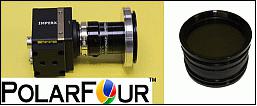
FTR observation technique: To obtain spectral information, the FTR camera first needs to be used to scan through the area of interest. Every pixel is then traced through the captured images as illustrated in Figure 9. The objective is to build up an interferogram for each and every image point as it passes through the fringe pattern. Finally, a Fourier transform of the interferograms is used to obtain the spectrum of the image points.
In the fringes itself, their position and intensity as well as the spectral information for each pixel of the image is coded. The camera is operated at a high data rate (100 Hz) to get as many scan lines as possible while the satellite is progressing over the target area.
Compared to conventional FTS/HSI cameras, the FTR camera is light and compact, making it suitable for use on small satellites.
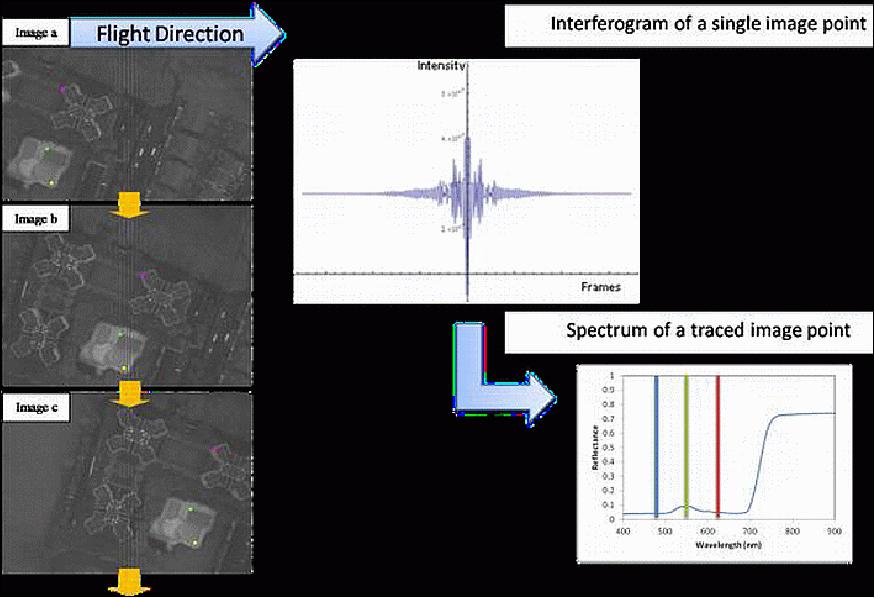
The new FTR camera technique has already been tested extensively by DSO in ground and in balloon campaigns. The next step is to integrate two FTR hyperspectral camera systems, referred to as PPL, into the Kent Ridge 1 microsatellite.
Primary Payload 1 and Primary Payload 2 (PPL1 and PPL2)
The two PPL hyperspectral instruments, including the DPU (Data Processing Unit), are designed and developed at BST. DSO provides the PolarFour filters (black discs in front of lens). PPL accommodation parameters: Mass: 5.96 kg; Size: 131 x 221 x 262 mm (Height x Width x Depth); Power: 30 W peak power.
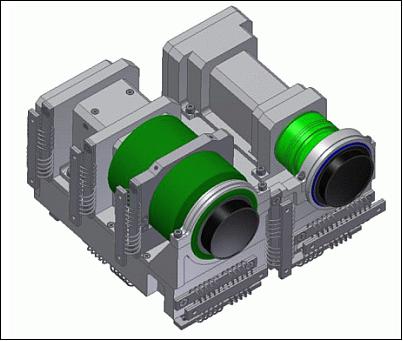
Parameter / Instrument | PPL1 | PPL2 | SPL |
Spectral range | 500-900 nm (VNIR) | 900-1500 nm (SWIR) | 450-630 nm (VIS) |
GSD (Ground Sample Distance) | 44 m | 110 m | 6 m |
Swath width | 47.5 km | 56.3 km | 5.75 km x 4.75 km |
No of channels | 20-30 | 20-30 | 3 RGB Bayer |
MTF @ Nyquist resolution | >0.2 | >0.2 | 0.1 |
SNR | >200 | >300 | >100 |
Bit depth | 8/10/12 | 12/16 | 8/12 |
Frame rate | 100/s | 100/s | 30/s |
Source data rate | 1.41 Gbit/s | 525 Mbit/s | 340 Mbit/s |
Data compression technique | JPEG2000 | JPEG2000 | H.264 |
Compression ratio | 4 | 4 | 40 |
SPL (Secondary Payload) Video Camera
SPL is a high resolution video camera with the objective to provide complementary imagery.
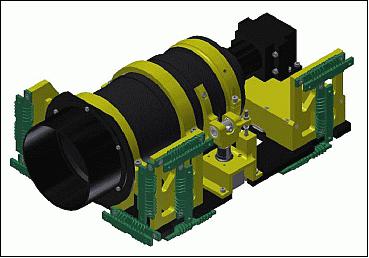
• All three cameras can be operated simultaneously
• Each of the three cameras has a DPU, and each of the DPUs has 248 GB of non-volatile (Flash) and 4 GB of volatile storage (RAM) attached.
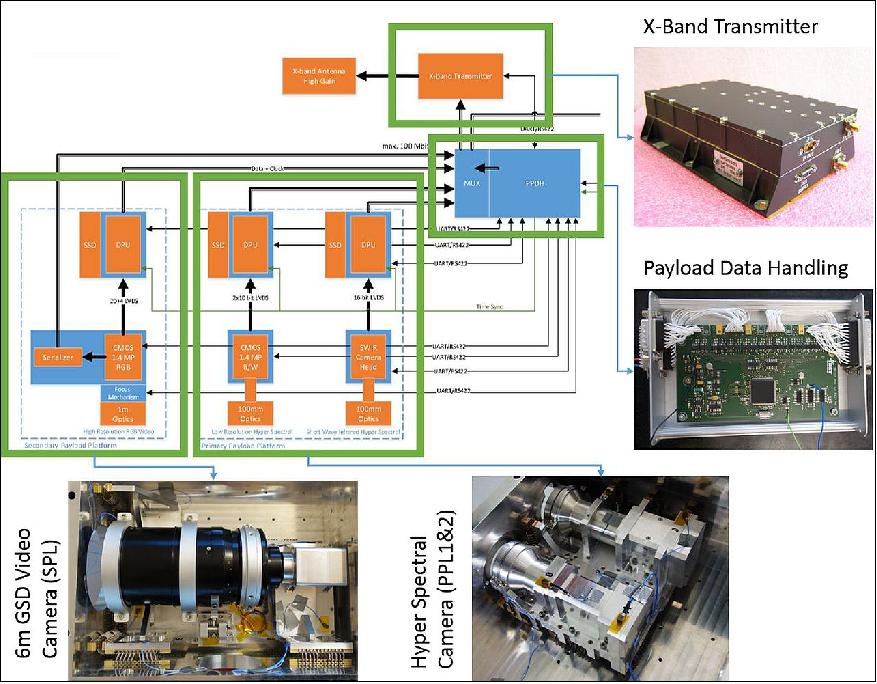
References
1) Tom Segert, Matthias Buhl, Björn Danziger, Cher Hiang Goh, Kee-Chaing Chua, Swee-Ping Yeo, "Kent Ridge 1 - a hyper spectral micro satellite to aid disaster relieve," Proceedings of the AIAA/USU Conference on Small Satellites, Logan, Utah, USA, August 2-7, 2014, paper: SSC14-VI-5, URL:
http://digitalcommons.usu.edu/cgi/viewcontent.cgi?article=3104&context=smallsat
2) Information provided by Tom Segert of BST (Berlin Space Technology), Berlin.
3) Tom Segert, Matthias Buhl, Björn Danziger, Goh Cher Hiang, Chua Kee-Chaing, Yeo Swee-Ping, "Kent-Ridge 1 – A high performance small satellite carrying a novel hyperspectral instrument operating in the VNIR and SWIR range," 10th IAA Symposium on Small Satellites for Earth Observation, Berlin, Germany, April 20-24, 2015, paper: IAA-B10-0401, URL of presentation:
http://www.dlr.de/iaa.symp/Portaldata/49/Resources/dokumente/archiv10
/pdf/0401_Kent_Ridge_1_for_IAA_Smallsat.pdf
4) "NUS takes the quantum leap into space," NUS, Dec. 16, 2015, URL:
http://www.alphagalileo.org/ViewItem.aspx?ItemId=159443&CultureCode=en
5) Stephen Clark, "PSLV completes commercial launch with six Singaporean satellites," Spaceflight Now, Dec. 16, 2015, URL: https://spaceflightnow.com/2015/12/16/pslv-set-for-commercial-launch-with-six-singaporean-satellites/
6) "India's PSLV Rocket orbits six Satellite for Singapore in year-closing Mission," Spaceflight 101, Dec. 16, 2015, URL: http://spaceflight101.com/pslv-c29/indias-pslv-rocket-orbits-six-satellite-for-singapore/
7) "India to launch 6 Singaporean satellites," Space Daily, Dec. 11, 2015, URL: http://www.spacedaily.com/reports/India_to_launch_6_Singaporean_satellites_999.html
8) "ST Electronics, Antrix, ATK, Satrec Initiative + SPOT Asia—The TeLEOS-1 Adventure Is Underway (Satellite—Launch Preparations)," Satnews, Feb. 6, 2014, URL:
http://www.satnews.com/story.php?number=1002365176
9) Information provided by Tom Segert of BST (Berlin Space Technology).
10) "Foray into space," NUS, Dec. 17, 2015, URL:
http://news.nus.edu.sg/highlights/9801-foray-into-space
11) "Pushing the Boundaries," DSO Highlights 2009/10, URL: http://www.dso.org.sg/cmsresource/20110309337087956336.pdf
12) "Hyperspectral Technology for Unmanned Aerial Vehicles," DSO, Emerging Technologies, pp: 127-133 [web source no longer available]
The information compiled and edited in this article was provided by Herbert J. Kramer from his documentation of: "Observation of the Earth and Its Environment: Survey of Missions and Sensors" (Springer Verlag) as well as many other sources after the publication of the 4th edition in 2002. - Comments and corrections to this article are always welcome for further updates (eoportal@symbios.space).
Overview Spacecraft Launch Mission Status Sensor Complement References Back to top